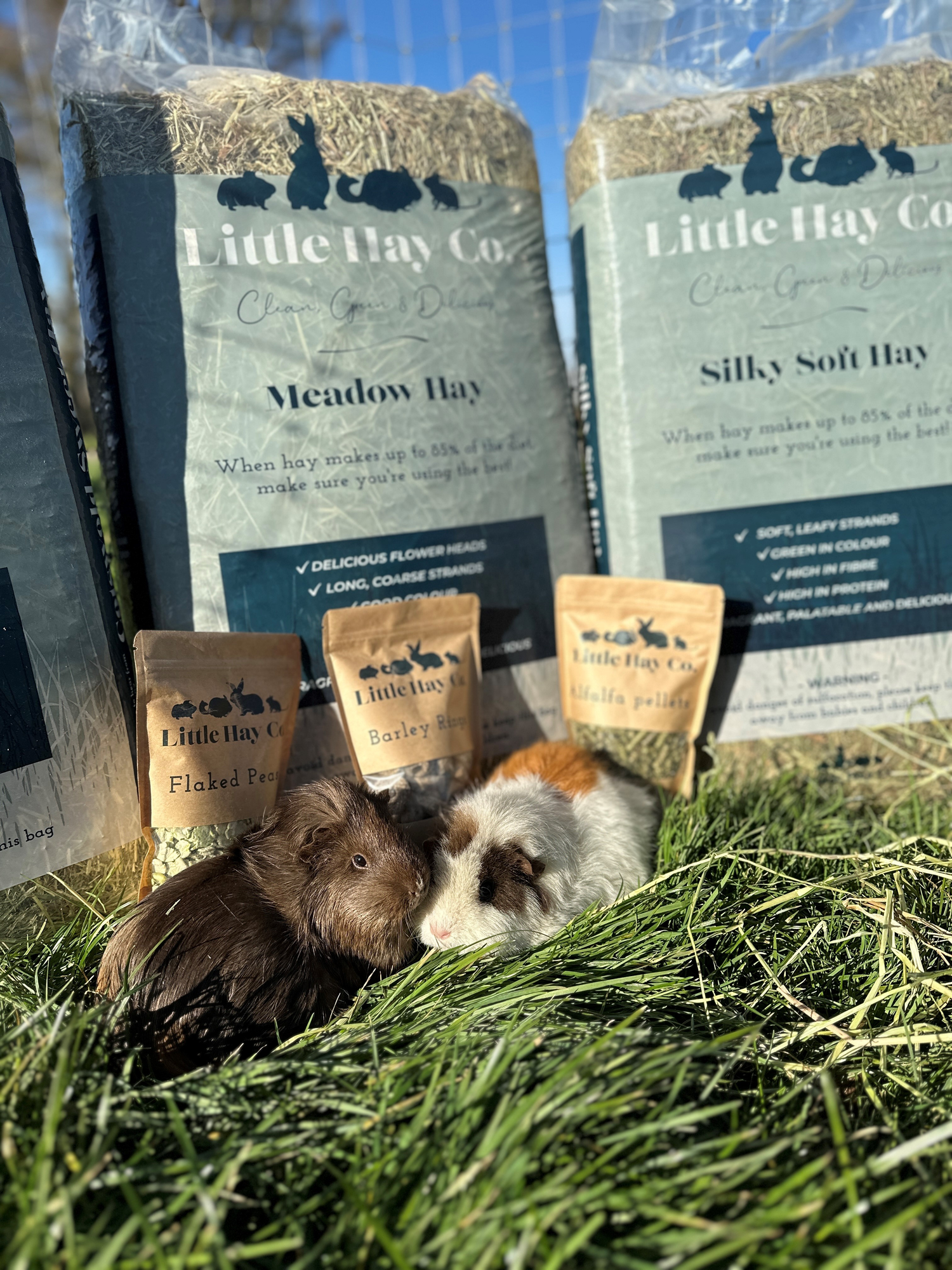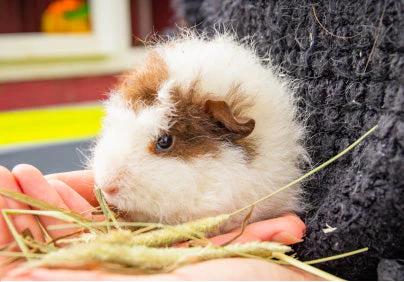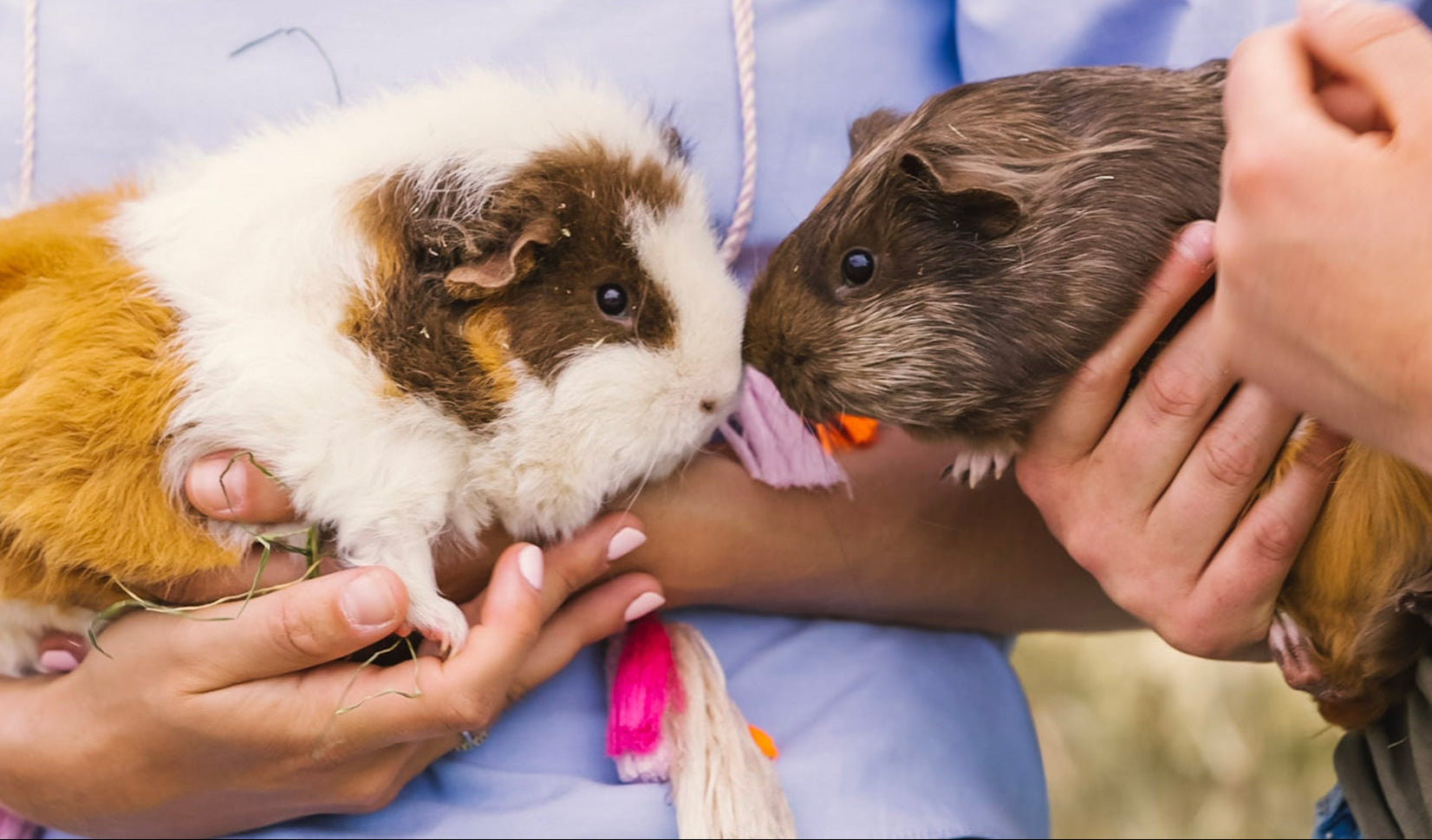We are going to face this question head on! While we know lots of customers have done their own research and feel confident feeding their pets Our Cotswold Sweet (Rye Grass) hay as a daily feed for their buns and Guinea pigs we wanted to help other customers with a unbiased and complete review of Rye grass from pasture to hay to help you understand the hay you are feeding and make the best choice for your pet!
What is Rye Grass?
You will hear lots of people say - "Hay is Hay" and it is and the make up of most grasses are very similar however there are a multitude of different grass seeds. At Little Hay Co we stock Timothy Hay, Rye Grass Hay and Fescue as our homegrown options. All three are combined in our Meadow Hay and Silky Soft hays while our Timothy and Cotswold Sweet are pure fields of Timothy Seed and Rye Grass seed respectively.
What is Rye Grass used for?
Rye Grass is a cultivated hay species first used for haylage production on farms.
In Modern Britain Rye Grass is a market leader for lawns for our gardens, it is almost weed like in it's ability to grow and thrive anywhere which is why it has become a popular choice for gardens, sports pitches and public green spaces.
It is also a popular seed choice for making hay in the UK. Like Timothy it is a relatively easy hay to grow taking around 60-65 days while Timothy takes around 50 days. The two grasses are planted at different times of the year allowing farmers a longer harvest season and a larger annual crop.
What is the make up of Rye Grass Hay?
Each harvest will vary which is why regular testing of the harvest should be conducted. We complete annual testing of hay in our stores as well as test hays once the harvest is completed and the bales have settled. Every hay producer should be able to provide customers with analysis of their hay which is no more than two years old to give you piece of mind. At Little Hay Co we test for Dry matter, Crude Protein, Neutral Detergent Fibre (NDF) and Actual Detergent Fibre (ADF), Sugar & Digestible Energy. We do a wider range of other tests too but these are the ones we will be covering in this blog.
Dry Matter - Dry matter is the weight of the hay minus any water content. This is the opposite of the moisture content we always talk about, we ensure all of our hays are dried to perfection with a moisture content of less than 12%. A lower moisture content avoids spores, fugus and toxins growing and developing in the hay. Our Rye Grass sits at around 94% dry matter which gives it an 6% moisture content which is just about perfect (if we do say so ourselves). Our Timothy and Meadow hays sit around 92% dry matter and 8% moisture.
Crude Protein - Adult rabbits don't require protein in the same way that they require fibre for a balanced diet. A hay below 10% Crude protein is usually a safe bet as a daily feeding hay for adult rabbits while baby rabbits will benefit from hays higher in protein such as Alfalfa Hay. Our Cotswold Sweet hay has a crude protein content of 6% while Timothy and Meadow contain 5% and 9% respectively. Comparatively, Alfalfa hay Crude Protein sits at around 24%.
Neutral Detergent Fibre (NDF) - This refers to Cellulose, hemicellulose & Lignin. We cannot stress enough that the amount of fibre that a rabbit eats will have the biggest impact on that animals health. Rabbits need fibre almost as much as they need oxygen, they are entirely reliant on it not only for their digestive health but also for their dental health. NDF is the fibre that will improve your pets gut barrier function and intestinal microbiota, hay should contain anywhere between 40%-65% NDF. Cotswold Sweet contains 48% NDF while Meadow contains 54% and Timothy contain 65%. A high NDF can result in a lower hay intake.
Acid Detergent Fibre (ADF): ADF measures the less digestible components of the plant cell wall, providing insight into the energy content of the hay. If an ADF figure is higher, this will mean the hay will be broken down less in the gut. The ADF figure is the fibre that is less digestible and forms the roughage that keeps your pets gut moving and forms those all important poos. The percentage you are looking for in hay is anywhere between 30-45%. Our Meadow Hay is around 32% ADF. Cotswold Sweet is around 30% & Timothy is around 39%.
Both NDF and ADF play a role in the gut health of your pet.
Sugar - The one everyone is talking about and the cause for concern amongst everyone right now. Sugar is unconverted fibre, all hays have some sugar in them and like humans rabbits can digest and consume small quantities of sugar. There is no such thing as a sugarless hay or sugarless grass for that matter. Sugar content is higher in grass than it is in hay so any research into pasture grasses and sugar content should be read with that in mind. Pasture grass sugar content fluctuates throughout it's lifecycle and throughout a 24 hour period due to a number of factors including weather, stress level,maturity and sunlight.
Mature Grasses have less sugar content than a juvenile grasses. The majority of the grass sugar content is stored in the bottom 3-4 inches. We believe that recent comments and concerns around illness in livestock and horses relates to pasture grass rather than dried and managed hay crops. Grass in pasture will have sugar content that varies throughout the day. Grass is a living organism and relies on photosynthesis to grow and thrive, sunlight during the day will increase photosynthesis in the plant stems resulting in an increase in sugar.
Our Cotswold Sweet hay is cut when it is fully grown with long stems and the seed heads are in abundance, this significantly reducing the sugar content of the grass at the time of the cut taking place. Our Cotswold sweet hay has a sugar content of 11% while our Timothy hay records a sugar content of 8% and our meadow hay sits around 10%.
Moderation of diet is key to a healthy pet - feed a variety of hays and ensure quantity is consumed while allowing them access to species safe forage and a treat a day.
Digestible Energy (DE) - This is like calorie counting and looks at the amount of energy in the hay that is digestible and used. This is the amount of energy absorbed and used for growth etc, if the DI is higher then your pet needs to be a little more active to use those calories. If your pet has access to the right size enclosure and enrichment throughout the day then no hay will cause any sort of weigh issues. Following the guidance of unlimited hay availability pets will be fine to eat any of our hays as a daily feeding hay. Cotswold Sweet and Meadow hay have Digestible Energy levels of 11mj/kg while meadow has 10mj/kg and Timothy has 8mj/kg.
Toxins
There are many different strains of ryegrasses in the UK, it is an indigenous species and has been produced for herbage seed for many decades. As a native species it formed part of our natural pastures, it grew particularly well in more fertile soils and was recognised very early as a key species to improve animal production instead of using tradtional meadows and permanent pastures which would contain a huge blend of species.
Ryegrass based swards have been a staple of ruminant systems for many decades, not just intensive systems, it is not necessarily quick or cheap to grow, although generally it is reliable as it is highly suited to our soils, climate and systems. On a nutritional level,it is also high in quality – D Value – or digestibility – that infers high levels of metabolisable energy or ME.
Perennial ryegrass (PRG) which is used in permenant pastures should not be confused with Italian Ryegrass (IRG). A permenant pasture will grow back year or year and is a more persistent grass while Italian Rye Grass is less persistent and will come in varieties varying from 1 year lays to 3 year lays. Rye grass can be referred to as Perennial, Westerwold or Italian, while these are three common names for this hay variety there are more than 50 seed types
The UK regulates the production and marketing of seeds. Manufacturers are required to register their seed varieties and have them certified for commercial marketing. Genetically modified Agricultural seeds are more heavily regulated with additional scrutiny and approval required through APHA and this is only approved it the GM improves cultivation or quality of the product.
Germinal plant breeding general targets are a disease resistance, quality, yield, – their breeding is based on recurrent selection, which is a little bit like breeding a pedigree dog or horse. It is not a Genetic modification process.
While it is true Rye Grass is has a marginally higher sugar content than other commonly fed hays it is important to understand that it is also high in fibre which is the backbone of a healthy diet for both rabbits and guinea pigs. Like Humans, Sugars are not detrimental if consumed in moderation and balance with other key nutritional elements such as Fibre, protein and digestible energy.
Sunlight, soil fertility, soil moisture, plant growth stage and many other factors will influence sugar levels. Once a grass leaf is cut and there is damage to the leaf blade, the sugars are transpiring as the plant dries, so sugar levels are much lower even just a few hours after the plant has been mown.
Endophyte types of grass are not currently used in the UK. Toxins are more commonly associated with hay through musty old leys carrying disease spores of various types of rust or moulds. This risk is associated with any variety of hay if it is not correctly grown, harvested, dried and stored.
Sources of concern regarding rye grass hays have been recorded in New Zealand, lolitrem B and ergovaline are commonly found in perennial ryegrass (Lolium perenne) infected with the endophytic fungus Neotyphodium lolii (now known as Epichloë festucae var. lolii).
Prevalence in the UK
The prevalence of lolitrem B and ergovaline in UK forage is generally lower compared to New Zealand due to several factors:
- Different Endophyte Strains: UK ryegrass cultivars don't use endophyte types of rye grass hay. Many UK strains do not produce high levels of toxic mycotoxins like lolitrem B and ergovaline .
- Climate and Environmental Conditions: The UK’s cooler and wetter climate is less conducive to the high levels of endophyte infection and mycotoxin production seen in New Zealand. This can result in a different profile of mycotoxins .
- Grass and Forage Types: The UK may use different species and varieties of grasses, which can influence the presence and types of mycotoxins. The ryegrass species in the UK might not favour the same endophyte-fungal relationships that lead to high levels of lolitrem B and ergovaline .
- Lolitrem B is the primary toxin responsible for ryegrass staggers, a neurological condition affecting livestock.
- Ergovaline is an ergot alkaloid that can cause vasoconstriction and associated problems in animals, such as fescue toxicosis.
All evidence and research of problems arising from these toxins are from studies conducted in New Zealand and Australia where all the factors that affect them as stated above differ greatly.
To our knowledge there have been no known cases of these toxins causing issues within UK livestock or pets for that matter. Many hay providers selling a form of Meadow hay will use rye grass as part of their seed base and so we feel confident that this grass has been marketed for many years and it is a safe and suitable fibre source for your pet.













